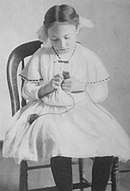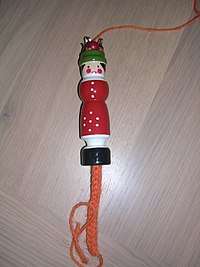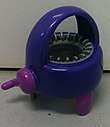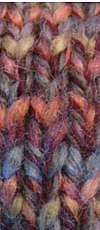Spool knitting
Spool knitting, corking, French knitting or tomboy knitting is a form of knitting that uses a spool with a number of nails around the rim to produce a narrow tube of fabric. The spool knitting devices are called knitting spools, knitting nancys, or French knitters.


The technique is to wrap the yarn around the spool's pegs. The yarn is then lifted over, thereby creating stitches. This process is repeated continually until the project is complete.
Spool knitting is a traditional way to teach children the basic principles of knitting. According to Mary McCormack, author of Spool Knitting (published in 1909), "Few elementary exercises have aroused more interest in the child than the toy knitting; due, perhaps, to its simplicity and his power to do it easily and well."[1][2]
Spool knitters typically have four or five pegs (or brass nails), although the number can range from sixteen to more than one hundred.[3]
Many things can be made from the resulting tube. For example, it can be wound in a spiral to produce a mat or rug or, if a larger spool with more nails is used, a sock or a hat could be made. Historically, spool knitting has been used to make horse reins.[3]
Spools sold as "knitting nancys" sometime had a picture of a girl painted or printed on them, thus resembling a wooden doll. Homemade knitting spools are sometimes made by placing a peg-like object, such as a nail, into a hard solid object, such as a block of wood.

I-cord is a similar, but not identical, knitting technique.
Knitting spools are the oldest members of the loom family, with a history dating back over 400 years.[4] It has been speculated, however, that the so-called Roman dodecahedra may have been used as glove knitting devices, dating to c. 1st–5th century CE.[5]
Beginning in the latter half of the 20th century, various small looms (usually plastic) using the same peg-knitting technique as knitting spools have been made. Some are larger than knitting spools, and can knit larger items. Some are straight, enabling flat items such as blankets or scarfs to be made, and some are round for making socks, hats, or other similar items. Simple versions contain just peg-like structures sticking up from a solid object. More complex ones operate complex mechanisms and automatically produce a knitted item with just a simple motion, such as a turn of a crank.
See also
References
- McCormack, Mary A. (Mary Anna) (1909). Spool knitting. New York : A. S. Barnes.
- Fisch, Arline M. (2003). Textile Techniques in Metal: For Jewelers, Textile Artists & Sculptors. Lark Books. pp. 64–. ISBN 978-1-57990-514-9.
- "Spool Knitter". historicalfolktoys.com. Historical Folk Toys. Retrieved 7 December 2014.
- Phelps, Isela (2007). Loom Knitting Primer: A Beginner's Guide to Knitting on a Loom, with Over 30 Fun Projects. Macmillan. pp. 8–. ISBN 978-0-312-36661-2.
- Metcalfe, Tom (August 6, 2018). "The Mysterious Bronze Objects that Have Baffled Archaeologists for Centuries". Pocket. Mental Floss. Retrieved 17 September 2019.
External links
| Wikimedia Commons has media related to Spool knitting. |
- Corking how to
- Spool Knitting Tutorials & Projects
- Spool knitting
- Mary A. McCormack. Spool Knitting at Project Gutenberg
